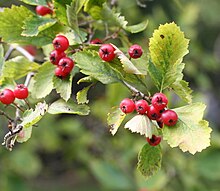Crataegus chrysocarpa is a species of hawthorn that is native to much of the continental United States and Canada. Common names fireberry hawthorn and goldenberry hawthorn, as well as the scientific name all refer to the colour of the unripe fruit, although the mature fruit is red[2] and in var. vernonensis is "deep claret-colored … nearly black when over-ripe".[3]
| Crataegus chrysocarpa | |
|---|---|

| |
| Scientific classification | |
| Kingdom: | Plantae |
| Clade: | Tracheophytes |
| Clade: | Angiosperms |
| Clade: | Eudicots |
| Clade: | Rosids |
| Order: | Rosales |
| Family: | Rosaceae |
| Genus: | Crataegus |
| Section: | Crataegus sect. Coccineae |
| Series: | Crataegus ser. Rotundifoliae |
| Species: | C. chrysocarpa
|
| Binomial name | |
| Crataegus chrysocarpa | |
Three varieties C. chrysocarpa var. chrysocarpa, var. piperi, and var. vernonensis are recognized.[3]
Images
edit-
Crataegus chrysocarpa var. chrysocarpa, wild vouchered tree from Montreal, Canada.
-
Fruiting Crataegus chrysocarpa var. chrysocarpa collected in Laval, Canada.
See also
editReferences
edit- ^ Botanic Gardens Conservation International (BGCI) & IUCN SSC Global Tree Specialist Group (2018). "Crataegus chrysocarpa". IUCN Red List of Threatened Species. 2018: e.T135957391A135957393. doi:10.2305/IUCN.UK.2018-2.RLTS.T135957391A135957393.en. Retrieved 2 June 2024.
- ^ Phipps, J.B.; O'Kennon, R.J.; Lance, R.W. (2003). Hawthorns and medlars. Cambridge, U.K.: Royal Horticultural Society. ISBN 0881925918.
- ^ a b Phipps, J.B.; O'Kennon, R.J. (2004). "A review of Crataegus series Rotundifoliae (Rosaceae) in western Canada". SIDA, Contributions to Botany. 21 (1): 65–77. JSTOR 41968974.
External links
edit
